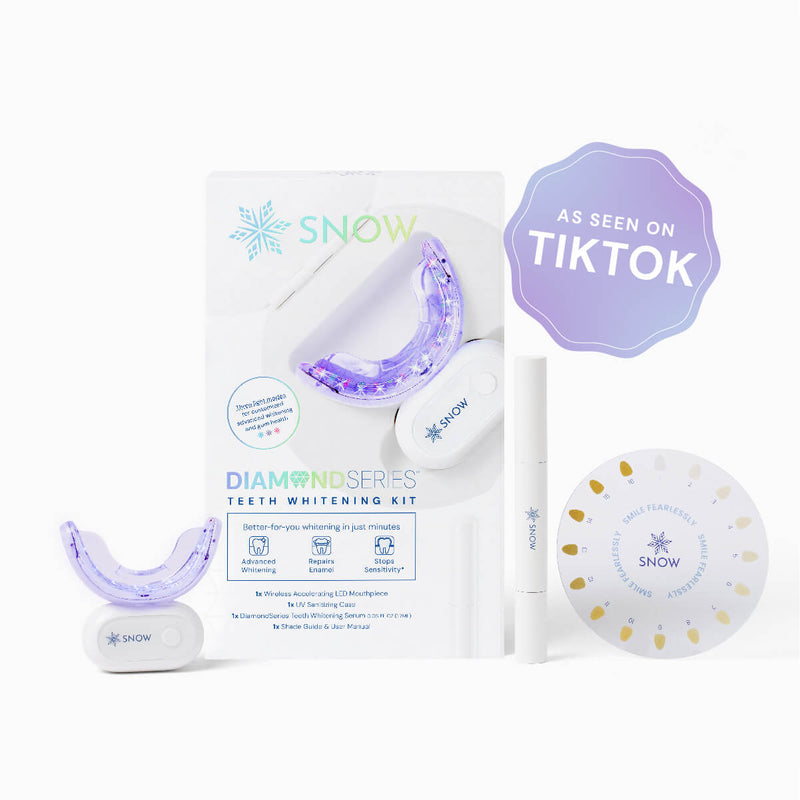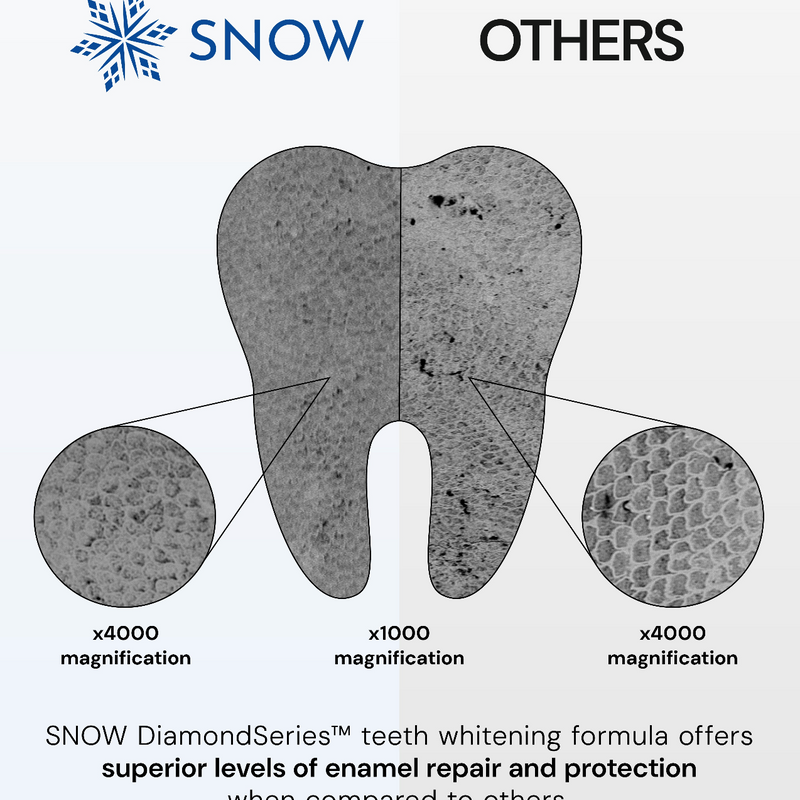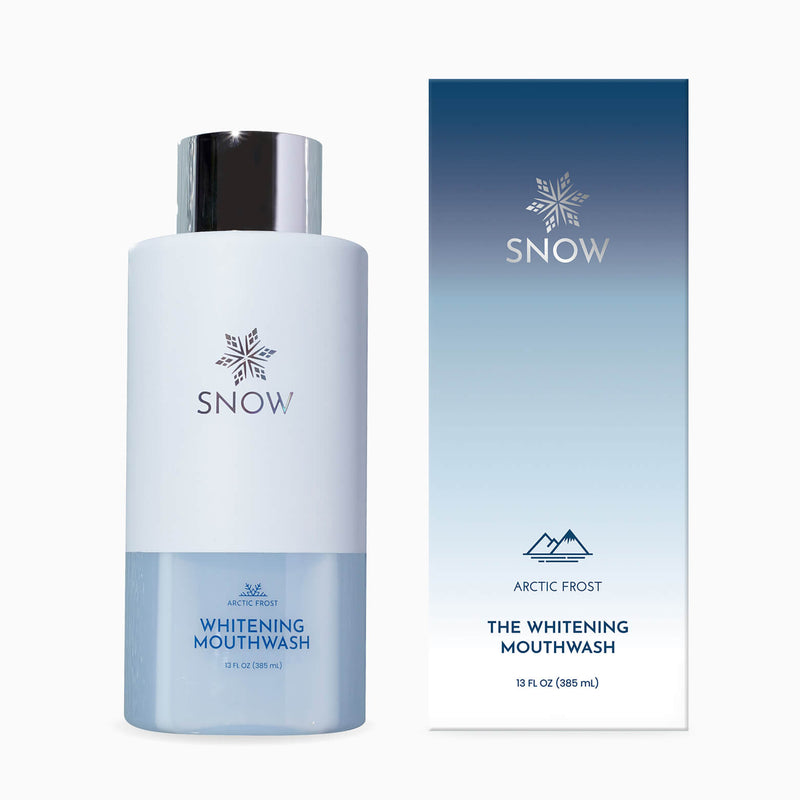If you've been struggling with yellow teeth, chances are you may feel embarrassed or less confident. Perhaps you hide your smile in group photos or cover your teeth during personal interactions with friends and family.
Teeth discoloration can creep up on people sometimes and it's totally normal. The good news is that a bright white smile is attainable.
It's natural for tooth discoloration to occur as you get older. Teeth turn yellow due to various factors such as age, diet, oral hygiene, and certain health conditions.
The medications you're taking can even affect the color of your teeth. Thankfully, teeth stains are removable with the right tooth whitening methods.
EXTRINSIC STAINS VS. INTRINSIC STAINS
Extrinsic stains are caused by foods, drinks, and external factors such as smoking, tobacco, and alcohol consumption.
Intrinsic stains are caused by genetic factors, age, and illness. Intrinsic stains are harder to whiten and may take more time to remove.
WHAT CAUSES YELLOW TEETH?
What does it mean when teeth are yellow? There could be several reasons behind tooth discoloration.
To find out why your teeth are yellow, you'll need to evaluate your daily habits and the potential causes. This will help you better understand the culprit behind discolored teeth.
Here are some of the most common causes of yellow teeth.
DARK-PIGMENTED FOODS AND DRINKS
Consuming certain foods and drinks can stain teeth. Dark-tinted foods such as coffee, red wine, blueberries (and other dark berries), beets, cola, balsamic vinegar, sports drinks, and soy sauce can discolor teeth.
To reduce or avoid tooth stains caused by certain foods and drinks, it's best to cut back on consumption.
For dark-tinted drinks, you can lessen the teeth staining effects by drinking them with a straw. If you do enjoy dark-pigmented foods, brush your teeth immediately after before the tooth enamel becomes stained.
SMOKING AND CHEWING TOBACCO
Tobacco products are known to alter the color of your teeth. Cigarettes, cigars, hookah, pipes, and chewing tobacco can turn teeth yellow.
The nicotine and tar found in tobacco products seep into the enamel of your teeth through small pores, causing discolored teeth. When these two chemicals combine with oxygen, tar creates a brown tinge and nicotine causes a yellow tinge.
Smoking can also cause tooth decay, oral cancer, and gum disease. These conditions can also lead to discoloration. The best way for smokers to fix yellow teeth is to quit smoking and use tooth whitening products to remove extrinsic stains.
HEALTH CONDITIONS
Health illnesses and medical conditions may cause yellow teeth. These illnesses include liver disease, kidney disease, metabolic diseases, calcium deficiencies, rickets, and celiac disease. Eating disorders can also cause discolored and unhealthy teeth. These conditions affect the enamel of your teeth and dentin (the part of your tooth that is under the enamel and cementum.)
Certain treatments for these conditions, such as radiation and chemotherapy, can also cause discolored teeth.
CERTAIN MEDICATIONS
Medications that can cause tooth discoloration may include antidepressants, antihistamines, high blood pressure medications, antipsychotics, and antibiotics (tetracycline and doxycycline).
GENETICS AND AGE-RELATED TOOTH DISCOLORATION
While you may have to double or triple-down on your oral care routine, you may notice that others seem to be more relaxed about their dental hygiene, all while sporting a white and healthy smile. Some people are born with genetics that naturally gives them brighter and stronger enamel.
Aging also causes a lack of whiter teeth. As people get older, the outer layer of enamel tends to wear down and expose the natural color of dentin. The color of dentin may be gray, black, or yellow.
FLUOROSIS
Fluorosis is a condition that is caused by overexposure to fluoride, usually in the first eight years of childhood. Consuming too much fluoride during these teeth-developing years can cause tooth stains. The teeth may be stained yellow or brown, or have white spots or streaks. In severe cases, the surface of the teeth may be rough and pitted.
According to Web MD, fluorosis affects 1 in 4 Americans from the ages of 6 to 49. Though it's most prevalent in children ages 12 to 15. The majority of cases are considered mild to moderate.
POOR ORAL HYGIENE
Poor oral hygiene is one of the leading causes of tooth decay, tooth discoloration, and gum disease. Poor dental hygiene results in plaque buildup, stained teeth, gingivitis, and periodontal diseases. Tooth decay can also begin to reveal yellowish dentin.
TOOTH TRAUMA
Dental injuries can be caused by sports, accidents, or bruxism (teeth grinding). Tooth trauma can weaken the tooth, cause discoloration, and impede enamel formation. This happens a lot to children however it can also affect adult teeth as well.

WAYS TO GET RID OF YELLOW TEETH
Now that you've learned all of the causes behind yellow teeth, you're probably looking for ways to whiten your teeth.
Thankfully, there are several teeth whitening treatments that can get rid of stubborn tooth stains. The right teeth treatment will whiten teeth and give you a beautiful bright smile.
Below are some of the most popular teeth whitening methods available.
IN-OFFICE PROFESSIONAL TEETH WHITENING TREATMENTS
Professional teeth whitening is an in-office treatment usually performed at a dentist's office. It's a safe and effective route to whiten teeth and remove deep teeth stains. During a professional teeth whitening treatment, dentists use a higher chemical concentration of tooth-bleaching agents.
The process may vary from dentist to dentist. However, here's what a teeth whitening appointment may involve. You and your dentist will decide how many shades whiter your teeth will be, your teeth will then be polished and cleaned, your gums and other parts of your mouth will be protected with a barrier since the whitening chemicals are strong and can irritate the gums.
A high concentration bleaching agent is then applied to your teeth with a syringe and a high-intensity light is then used to increase the effects of the hydrogen peroxide.
In-office teeth whitening treatments usually take one to several short visits depending on your personal needs and may last 30 minutes to 2 hours. After the treatment is complete, your mouth will be rinsed. Your dentist will also provide you with after-care tips to ensure your smile stays white.
This process leads to whiter teeth that may last up to three years if you take great care of your teeth.
The pros of in-office whitening are that it yields excellent long-lasting results and you're also in the care of a trained professional, which is reassuring. The cons are that the price tag is heftier than other treatments, professional whitening can cost $500 to $1000 per treatment.
AT-HOME TEETH WHITENING TREATMENTS
At-home whitening products have become a very popular way to whiten teeth in the comfort of your home. There are many safe and effective over-the-counter drugstore products that yield great results and whiten teeth gently. Consider your personal goals, time, and price range when it comes to searching for at-home teeth whitening treatments.
Here are a few of the most popular options:
BRUSH-ON WHITENING GEL PENS
Whitening pens are filled with a gel or serum that is brushed onto the teeth. They're great for removing surface stains and addressing tooth discoloration. They're also effective at getting hard-to-reach areas between the teeth.
LED WHITENING TECHNOLOGY
There are many at-home whitening kits that address yellow teeth with LED technology. Similar to an in-office whitening treatment, except you can do it yourself in the comfort of your home. These devices utilize whitening gels and a mouthpiece that lights up with LED light.
WHITENING STRIPS
These are designed to be placed over the surface of your teeth for a specific amount of time. They contain hydrogen peroxide (this helps with stain removal) and can lighten your teeth up to three to five shades. Whitening strips are very discreet, making them convenient to wear during daily activities.
At SNOW, we offer The Magic Teeth Whitening Strips®. They strip away stains and dissolve in under 15 minutes.They're also made with patented P3 Technology® that whitens more effectively than other dissolvable whitening strips on the market. Shop The Magic Teeth Whitening Strips®.
WHITENING TOOTHPASTE
An effective whitening toothpaste removes extrinsic stains from your teeth. Many brands of whitening toothpaste also contain hydrogen peroxide and carbamide peroxide, two chemicals that help lighten your teeth. Toothpaste usually has mild abrasives in it as well, this helps polish your teeth for additional effectiveness.
SNOW also offers The Whitening Toothpaste. It's designed for sensitive teeth and provides lasting freshness while also tackling stains. Shop The Whitening Toothpaste.
WHITENING TRAYS
There are custom-made at-home whitening trays, where a dentist makes a mold of your teeth to create fitted dental trays, and there are over-the-counter trays you can buy at a drugstore. Both options come with a bleaching agent or gel that whitens your teeth.
When whitening your teeth at home, make sure that you follow the exact directions according to the product. Leaving these treatments on for too long can lead to soreness and unnecessary pain. Extra time does not increase their effectiveness. Make sure to protect your teeth and don't overdo it.
The pros of home whitening treatments are that they're convenient, they yield impressive results, and they're cost-effective. The cons are that you don't have dental supervision and guidance.
Some products may cause side effects, sensitivities, or allergies. Do-it-yourself methods may also not last as long as professional treatments since the whitening agent concentration is not as strong as what a dentist would use.
ARE AT-HOME WHITENING TREATMENTS SAFE?
Yes, home whitening treatments are considered safe.
Studies have shown that at-home whitening treatments are safe and effective. The bleaching chemicals found in over-the-counter products are not as strong as professional-grade treatments. You may experience intense tingling if your teeth and gums are more sensitive. If you're concerned due to personal dental issues, it's best to check with your dentist first.
One of SNOW's fan favorites (and a bestseller) is the SNOW At Home Teeth Whitening Kit. If you want to whiten your teeth from the comfort of your own home, this is the way to go.
The kit delivers a professional-level teeth whitening experience and is formulated to be gentle on enamel for those with sensitive teeth and gums. It was also formulated with leading cosmetic dentist, Dr. Brian Harris. Shop The Teeth Whitening Kit.

HOME REMEDIES
If you prefer to take a more holistic route in pursuit of pearly whites, there are plenty of home remedies that can help whiten yellow teeth. These treatments may produce temporary side effects such as tingling, sensitivity, and gum irritation.
Here are some of the most popular home remedies for discolored teeth.
Hydrogen peroxide. Hydrogen peroxide is a natural bleaching agent that can be used to whiten yellow teeth. Bleaching helps with intrinsic and extrinsic stain removal. Look for products that have hydrogen peroxide such as toothpastes, mouthwash, gels, and strips.
Baking soda. Chances are you have baking soda in your pantry right now. You can make a home whitening paste by mixing 1 part baking soda to 2 parts hydrogen peroxide. By adding water, you can make a mouth rinse as well. You can also shop for whitening products that contain baking soda such as toothpaste and mouthwash. Baking soda has been proven to be effective in lifting tooth stains and whitening teeth.
Apple cider vinegar. You can make a mouth wash with apple cider vinegar by mixing 1 teaspoon of vinegar and 3 ounces of water. Research shows that apple cider vinegar and white vinegar have bleaching affects on teeth.
Coconut oil pulling. Oil pulling is a traditional Indian practice. You swish coconut oil in your mouth for 15 to 20 minutes a day. This process helps clean your teeth and may kill plaque and bacteria that may be causing yellow teeth.
Curious how SNOW's LED Electric Toothbrush stacks up against the competition? This site recently put our toothbrush to the test and performed a comparison across other top brands (Sonicare, Quip, & Burst). Check out the Snow Whitening Toothbrush Review.
PRACTICE GOOD ORAL HYGIENE
In order to keep your teeth healthy and white, you'll need to brush your teeth regularly, floss, and use mouth rinses. The American Dental Association recommends that you brush your teeth twice a day. You'll also need to schedule routine teeth cleanings with a dental professional every six to twelve months. Don't let poor oral hygiene ruin your beautiful smile.
FAQs
Can yellow teeth become white again?
Yes. Yellow stains on your teeth are often located on the tooth's enamel, the layer closest to your tooth's surface, and can typically be removed by using whitening treatments.
What does it mean if your teeth are yellow?
Dentin darkens with age, but yellow teeth are mostly caused by what you eat and drink staining your enamel. Coffee, tea, and red wine contain strong pigments that adhere to your enamel and change the color of your teeth. Plaque accumulation can also occur, causing teeth to become tinged and yellow.
Are yellow teeth stronger?
The ingredients in teeth whitening treatments may weaken teeth if they're over used. Treatments can also sometimes make the teeth more sensitive. So yes, in many cases yellow teeth are generally stronger than bright white teeth.
How long does it take to whiten stained teeth?
It depends on the treatment or brand. The whitening process may often take one to three weeks to whiten naturally yellow teeth or as long as two to three months for more severe stains. It also depends on the intensity of the ingredients.
SUMMARY
There are several factors that can cause yellow teeth. In order to have a bright white smile, it's best to assess your lifestyle habits, practice good oral hygiene, and use whitening treatments that work for your personal needs and budget. You deserve to smile confidently.


























